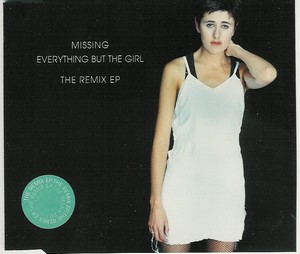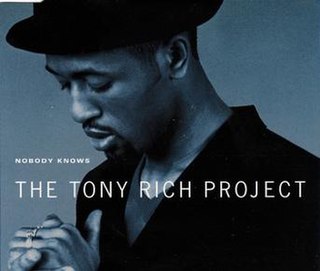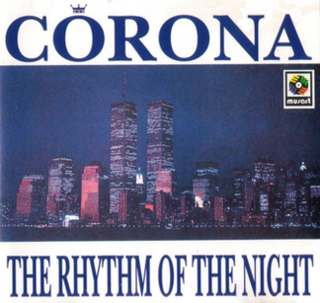
"Regret" is a song by British alternative rock band New Order. It was released on 5 April 1993 by London Records as the lead single from their sixth studio album, Republic (1993). Stephen Hague is credited as both the producer and as a co-writer. It was the band's first single released on CentreDate Co Ltd following the collapse of Factory Records.

La Bouche is a German-American Eurodance duo best known for the hits "Be My Lover", "Sweet Dreams", "You Won't Forget Me" and "S.O.S." La Bouche was founded in 1994 by record producer Frank Farian in Frankfurt am Main. He worked together with techno DJ Ulli Brenner and producer Amir Saraf to produce the music, while American singer Melanie Thornton and American rapper and backup singer Lane McCray fronted the act.

Melanie Janene Thornton was an American pop and dance music singer. She was the lead singer of the Eurodance group La Bouche from 1994 to 2000, alongside American rapper and backing vocalist Lane McCray. Their two most successful singles, "Sweet Dreams" and "Be My Lover", were released in 1994 and 1995 respectively. After leaving the group, Thornton began a solo career and found success primarily in European countries before her death in 2001. Her solo songs include "Love How You Love Me", "Heartbeat", "Makin' Oooh Oooh " and "Wonderful Dream ".

"Get Ready for This" is a song recorded by Belgian/Dutch music group 2 Unlimited. It was released in 1991 as the lead single from their debut album, Get Ready! (1992). Originally, the single was produced as an instrumental, titled the "Orchestral Mix". It became a hit and conscious of their popularity, Wilde & De Coster wanted a more accessible, formatted formula for their project to grow. Ray was then asked to write lyrics and add a rap to the track. On Ray Slijngaard's suggestion, Anita Doth joined as the female vocalist.

"Be My Lover" is a song recorded by German Eurodance group La Bouche and released in March 1995 by Arista and RCA as the second single from their debut album, Sweet Dreams (1995). The song was written by group members Melanie Thornton and Lane McCray with Uli Brenner and Gerd Amir Saraf, who co-produced it with Frank Farian. It remains their most successful song, alongside "Sweet Dreams", and was a worldwide hit. In Europe, it was a number-one hit in the Czech Republic, Germany, Hungary, Romania, and Sweden, as well as on the Eurochart Hot 100. In the US, the single reached numbers five and six on the Cash Box Top 100 and Billboard Hot 100, and also topped the Billboard Hot Dance Club Play chart for two weeks in December 1995. To date, it has sold six million copies worldwide. Two different music videos were produced to promote the single. "Be My Lover" earned La Bouche the 1996 Echo award in Germany in the category for Best Dance Single as well as the ASCAP award in the US for the 'Most Played Song in America'. It was dubbed into many megamix tracks and has had several remix versions.

"Beautiful Life" is a song by Swedish band Ace of Base, released on October 20, 1995 from their second album, The Bridge (1995). In North America, it was the first single released from the album; in Europe, it followed "Lucky Love" as the second single. Co-written by band member Jonas Berggren and produced by him with Denniz Pop and Max Martin, the single reached number 15 on both the US Billboard Hot 100 and the UK Singles Chart in December 1995. It reached number one on the Canadian RPM Dance/Urban chart and Billboard's Hot Dance Club Play chart. In 2017, BuzzFeed ranked "Beautiful Life" number 51 in their list of The 101 Greatest Dance Songs Of the '90s.

"Here Comes the Hotstepper" is a song co-written and recorded by Jamaican dancehall artist Ini Kamoze. It was released as the lead single from his 1995 album of the same name as well as the soundtrack to the film Prêt-à-Porter. It is known for its "naaaa na na na naaaa..." chorus inspired by the Cannibal and the Headhunters version of "Land of 1000 Dances".

"Daddy Cool" is a song produced and co-written by Frank Farian who had founded the group Boney M. to visually perform to his songs on TV and while touring discos. Farian also provided the male voice parts on the record. The song was included on their debut album Take the Heat off Me. It was a 1976 hit and a staple of disco music and became Boney M.'s first hit in the United Kingdom.

"Missing" is a song by English musical duo Everything but the Girl, taken from their eighth studio album, Amplified Heart (1994). It was written by the two band members, Tracey Thorn and Ben Watt, and was produced by Watt and John Coxon. It was taken as the second single off the album on 8 August 1994 by Blanco y Negro Records in the United Kingdom and by Atlantic Records in the United States. It initially did not achieve much success until it was remixed by Todd Terry and re-released in 1995, resulting in worldwide success, peaking at or near the top of the charts in many countries. The release of the remixed version of "Missing" gave an indication of the band's future experimentation with more electronic dance music on subsequent albums.

"Where Do You Go" is a song written by Peter Bischof and Frank Farian. It was first recorded in 1995 by German Eurodance band La Bouche as an album-only track from their debut album, Sweet Dreams (1995). A cover version of the song was then recorded by German pop trio No Mercy, taken from their debut album, My Promise (1996). On 13 May 1996, it was released as their first single and became a worldwide hit entering the top five in Australia, Austria, Belgium, France, Germany, Hungary, Lithuania, Switzerland, the United Kingdom, and the United States.

"Mr. Vain" is a song by German musical group Culture Beat, released in April 1993 by Dance Pool as the lead single from the group's second studio album, Serenity (1993). The song was written by Steven Levis, Nosie Katzmann and Jay Supreme, and produced by Torsten Fenslau. Tania Evans is the lead vocalist and Supreme is the rapper. The female part of the lyrics describes the narcissist title character Mr. Vain, while the rap embodies his selfish desires.

"Girl You Know It's True" is a song by Maryland-based group Numarx, later made internationally famed by German dance-pop group Milli Vanilli. Released as the lead single from MV's European debut album, All or Nothing (1988), and the duo's American debut album, Girl You Know It's True (1989), the song peaked at number one on the German Singles Chart, number two in the United States and number three in the United Kingdom, becoming one of Milli Vanilli's most successful singles.

"Nobody Knows" is a song by R&B singer Tony Rich from his 1996 debut album, Words. Released as his debut single on November 7, 1995, the song peaked at number two on both the Billboard Hot 100 and Billboard Hot Adult Contemporary Tracks charts. It also became a hit in several other countries, topping the Irish Singles Chart and reaching number two in Australia and Canada, number four in the United Kingdom, and the top 20 in the Netherlands, New Zealand, and Sweden. Rich received a nomination for the 1997 Grammy Award for Best Male Pop Vocal Performance.

"100% Pure Love" is a song recorded by American singer and songwriter Crystal Waters from her second studio album, Storyteller (1994). It was released on April 11, 1994 by Mercury and A&M (UK), as the album's lead single. The song was a hit in many countries, reaching the top 20 in Australia, Finland, the Netherlands, Switzerland, the United Kingdom, and the United States. It is certified platinum in Australia and gold in the US. In 1995, it was awarded the prize for Top ASCAP Dance Song. And its accompanying music video, directed by Marcus Nispel, was nominated for Best Dance Video at the 1994 MTV Video Music Awards.

"Dreamer" is a song by Italian house group Livin' Joy, written and recorded by Janice Robinson and produced by brothers Paolo and Gianni Visnadi. Originally released in August 1994, it was re-released in 1995 by MCA and topped the UK Singles Chart at the number one spot that May, ending 1995 as the UK's 40th-biggest-selling single of 1995. In the United States, it went to number-one on the Billboard Hot Dance Club Play chart. It was a sleeper hit on pop radio, but finally managed to peak at number 72 on the Billboard Hot 100 and number 75 on the Cash Box Top 100.

"I Love to Love" is a song recorded by German Eurodance group La Bouche, released in November 1995 as the fourth and last single of their debut album, Sweet Dreams (1995). The song achieved a minor success in comparison with "Be My Lover" and "Sweet Dreams", but made it to number five in Hungary and number six in Australia. On the Eurochart Hot 100, it reached number 37 in February 1996. In Canada, "I Love to Love" peaked at number two on the RPM Dance/Urban chart. The CD maxi's cover features also the title of the fourth track, a cover of "Forget Me Nots", another song taken from the same album. "I Love to Love" earned a gold record in Australia, with a sale of 35,000 singles.

"The Rhythm of the Night" is a song by Italian Eurodance group Corona. It was released as their debut single in 1993 in Italy, then elsewhere the following year. The song is the title track of the group's debut studio album, The Rhythm of the Night (1995), and was written by Francesco Bontempi, Annerley Emma Gordon, Giorgio Spagna, Pete Glenister and Mike Gaffey. It was produced by Bontempi, and the vocals were performed by Italian singer Giovanna Bersola, who is not credited on the single and does not appear in the music video. The woman who appears in the video is the group's frontwoman Olga Souza. The video was A-listed on Music TV-channels, such as Germany's VIVA. The song was a worldwide hit in 1994, peaking at number-one in Italy, and within the top five in most of Europe, while in the US, it fell short of the top ten, reaching number eleven on both the Billboard Hot 100 and the Cash Box Top 100.

"Fallin' In Love" is a song by American music trio Hamilton, Joe Frank & Reynolds. It was written by band member Dan Hamilton and featured on the trio's third studio album by the same name (1975).

Sweet Dreams is the debut studio album by German Eurodance duo La Bouche. Four singles were released from the album: "Sweet Dreams", "Be My Lover", "Fallin' in Love" and "I Love to Love". The album was very successful all over the world, reaching number two in Finland and Switzerland, and number three in Germany. It sold to gold in countries like Canada, Finland, Germany, Hong Kong, Japan, Poland and Switzerland.

"Bolingo (Love Is in the Air)" is a song recorded by German Eurodance group La Bouche, released in October 1996 by various labels as a single. It achieved moderate success on the charts in Europe, entering the top 20 in Austria (19), Denmark (19), Finland (15) and Switzerland (15). On the Eurochart Hot 100, the song reached number 47 in December 1996. Its music video was shot in Ibiza, Spain.




















